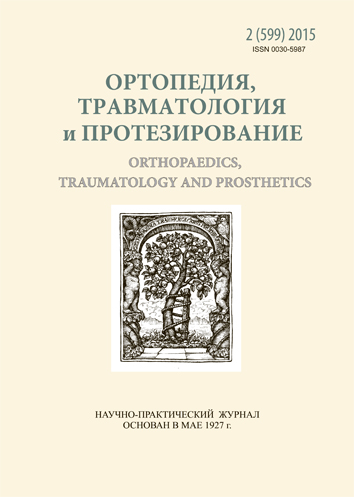Total knee arthroplasty with the cement endoprosthesis «motor sich epk-2»
DOI:
https://doi.org/10.15674/0030-59872015267-69Keywords:
knee joint, arthroplasty, osteoarthritisAbstract
Arthroplasty is one of the main methods in surgical treatment of osteoarthritis in the later stages when there was already significant joint destruction happend. Motor Sich JSC produces medical products for over 20 years. In 2002 there was created, and in 2005 was started serial production of the first and the sole domestic knee endoprosthesis. Objective: To study the first results of knee replacement by means of implants «Motor Sich EPK-2». Methods: The work is based on the results of treatment of 96 patients (69 women and 27 men aged 35 to 80 years) with gonarthrosis in stages III–IV. In all patients we performed primary knee replacement with preservation of the posterior crucial ligament using implants «Motor Sich EPK-2». All patients received intraoperative antibiotic therapy with cephalosporins. Outcomes were assessed in the period from 1 to 6 years with the help of clinical, radiological methods, and a scale «Knee Society Score» (KSS). Results: according to subjective assessment of treatment there were revealed 50.0 % excellent results; Good 43.3 %, and 6.7 % of patients noticed improvement. After a year or more after surgery in the operated joint flexion was 90° or more, and 89 % of the patients could walk without additional support. Complications that led to substitution of the endoprosthesis have took place in 4 cases — deep infection (1), instability of tibial (2) and femoral (1) components. Survival of endoprostheses in terms up to 6 years was about 96 %. Conclusion: as a result of using of the knee joint endoprosthesis «Motor Sich EPK-2» there were obtained positive results in 96 % of patients up to 6 years after surgery which indicates that the high efficiency of this construct in the treatment of patients with knee joint osteoarthrosis in stage III–IV.References
- Dedukh N. V. Relationship between osteoarthritis and osteoporosis (experimental-clinical research) / N. V. Dedukh, Z. N. Danischuk, V. A. Filipenko // Problems of osteology. — 2006. — V. 9 supplement. — P. 40.
- Zazіrny I. M. Surgical treatment of knee osteoarthritis / I. M. Zazіrny, M. K. Ternovij. — Kyiv, 2005. — 192 p.
- Loskutov O. A. Stiffness and strength properties of different brands of bone cement based on polymethylmethacrylate and their changes with time / O. A. Loskutov, E. V. Vasilchenko, M. J. Ambrazhey // Trauma. — 2014. — V. 15, № 3. — P. 114–117.
- Osteoarthritis: conservative therapy: Monograph / [N. A. Korzh, I. A. Zupanets, N. V. Dedukh et al.]. — Kharkov: Golden Pages, 2007. — 424 p.
- Endoprosthesis of human joints: Materials and Technologies: Monograph / [N. V. Novikov, O. A. Rosenberg, J. Havlík et al.]. — K., 2011. — 527 p.
- Rationale of the knee society clinical rating system / J. N. Insall, L. D. Dorr, R. Scott, W. N. Scott // Clin.Orthop. — 1989. — Vol. 248. — P. 13–14.
Downloads
How to Cite
Issue
Section
License
Copyright (c) 2015 Vadim Chorny

This work is licensed under a Creative Commons Attribution 4.0 International License.
The authors retain the right of authorship of their manuscript and pass the journal the right of the first publication of this article, which automatically become available from the date of publication under the terms of Creative Commons Attribution License, which allows others to freely distribute the published manuscript with mandatory linking to authors of the original research and the first publication of this one in this journal.
Authors have the right to enter into a separate supplemental agreement on the additional non-exclusive distribution of manuscript in the form in which it was published by the journal (i.e. to put work in electronic storage of an institution or publish as a part of the book) while maintaining the reference to the first publication of the manuscript in this journal.
The editorial policy of the journal allows authors and encourages manuscript accommodation online (i.e. in storage of an institution or on the personal websites) as before submission of the manuscript to the editorial office, and during its editorial processing because it contributes to productive scientific discussion and positively affects the efficiency and dynamics of the published manuscript citation (see The Effect of Open Access).














